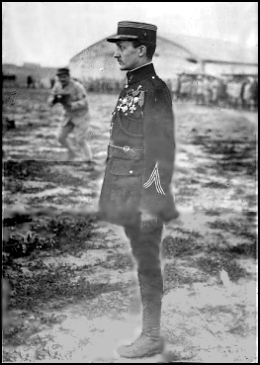
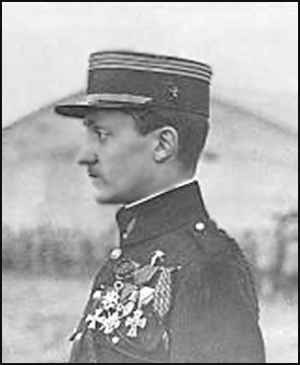
1894-1917 AKA Georges Marie Ludovic Jules Guynemer |
 |
 |
from the Library of Congress Collection, 10-3-07 |
|
|
|
"The Most Brilliant Stork" |
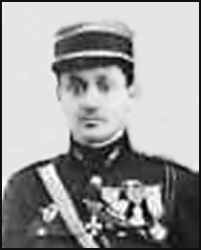 |
from Rosebud's WWI and Early Aviation Image Archive You will find numerous images of Guynemer on this valuable website. |
|
|
|
If time permits, I think you will enjoy going to the homepage of the site and sampling some of the other valuable features. |
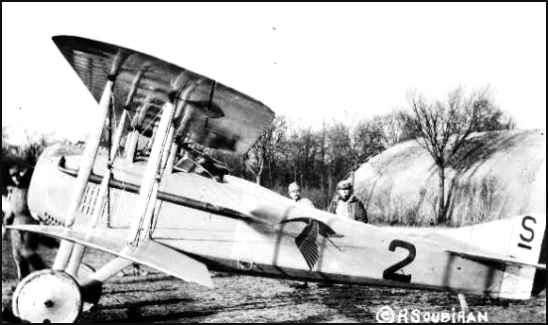 |
Library of Congress Collection, 9-29-07 |
 |
The GREAT WAR in the AIR John H. Murrow, Jr. Product Details Hardcover: 32 pages 9.5 x 6.5 x 1.8 inches Publisher: Smithsonian Institution Press (April 17, 1993) Language: English ISBN-10: 1560982381 ISBN-13: 978-1560982388 Dimensions: 9.5 x 6.5 x 1.8 inches |
|
An excerpt from a Smithsonian aviation series book Courtesy of Greg Powers, 11-2-07 "The legendary Georges Guynemer was the star in [the] firmament of aces. In eight months in 1917, the fragile youth shot down 28 planes, including a quadruple victory on 25 May, for a total of 53 victories. Unlike fliers who broke off combat once they lost the advantage of surprise, Guynemer refused to release a prey. This self-proclaimed "killer of Germans' was consequently wounded twice and shot down eight times. Keenly interested in his airplane, Guynemer became friends with Spad designer Louis Bechereau and often wrote from the front and visited the factory to describe his combats and suggest improvements to the planes. He even had his own personal Spad 12 with a 37 mm Hotchkiss cannon firing through the propeller axis. To speak of Guynemer in knightly metaphors may not be hyperbole. In June, after some 20 minutes in inconclusive combat with an Albatros D5, Guynemer noticed that his adversary’s gun had jammed. He waved farewell and broke off the flight, leaving his opponent (the source of this account), six-victory German ace Ernst Udet, so stunned and disturbed that he had to take an extended leave. Militarily speaking, Guynemer’s gesture proved absurd. Udet later shot down 52 more Allied aircraft, became Germany’s second-highest-scoring ace, and survived the war. Guynemer expected to die in the service of France. When Guynemer’s father warned in the summer of 1917 that there were limits to human powers, he replied, "Yes, limits that it is necessary to exceed. So long as one has not given everything, one has given nothing.' In early September a tired and depressed Guynemer, visiting his wounded squadron mate Heurtaux in the hospital, predicted that he would be the next to die. Two days later, on 11 September, Guynemer disappeared over Poelcapelle, as the Battle of Flanders (7 July-6 November) claimed another victim. Ill, possibly with tuberculosis, and under excessive nervous strain, he should not have been flying, but he refused to stop. French schoolchildren were told that he had flown so high that he could not descend. On 19 October the National Assembly and Senate enshrined "Capt. Guynemer, symbol of the aspirations and enthusiasm of the army of the nation," in the Pantheon, "whose cupola alone has sufficient span to shelter such wings." The slender youth embodied the victory of the spirit over the flesh, of France’s will to endure despite her grave wounds. Guynemer’s self-appointed avenger, his successor as French ace of aces, Rene Fonck, was a study in contrast to Guynemer. The short, stocky Fonck took no risks, attacked only when he had the advantage, and sped away as quickly as possible as he had struck, his own aircraft, by his account, never touched by bullets. He did not have to get close to his target. An extraordinary shot with tremendous reflexes and remarkable eyesight, he honed his aim by shooting 50-centime coins thrown into the air at 10 paces with a carbine. Cold-blooded and arrogant, he never seized the imagination of his countrymen as Guynemer had. Not even the indomitable ace Charles Nungessor, who walked with a cane and occasionally had to be lifted into the cockpit, could equal the mythological Guynemer.' From: John H. Murrow, Jr. The Great War in the Air: Military Aviation from `909 to 1921. Smithsonian History of Aviation Series. Smithsonian Institution Press. Washington and London, 1993. Pages 202-203. |
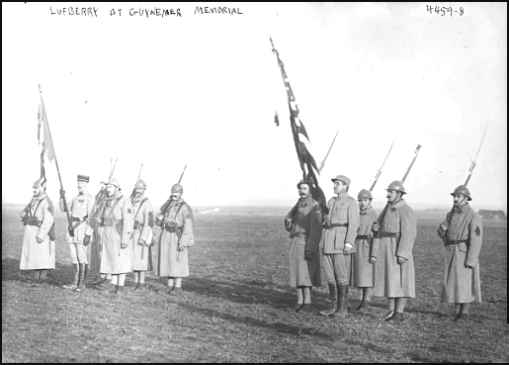 |
Library of Congress Collection, 9-29-07 |
|
from The Aerodrome If you have any more information on this pioneer aviator please contact me. E-mail to Ralph Cooper |


|